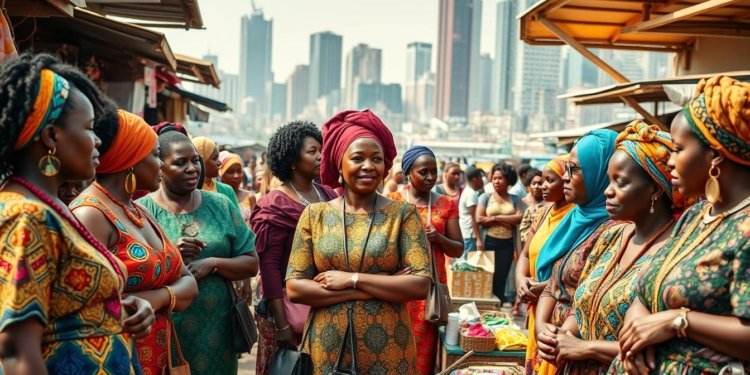Did you know that gender inequality costs sub-Saharan Africa 95 billion USD in lost productivity every year? Women entrepreneurs hold the key to unlocking economic growth, yet many face barriers that limit their potential. This article explores how targeted initiatives are changing the game.
From the UN’s Beijing Platform to corporate programs like De Beers Group’s AWOME, efforts are growing to support female-led businesses. Success stories, such as Namibia’s Sunny-Girl Hauwanga, prove what’s possible with the right resources.
We’ll break down the challenges, highlight effective solutions, and share actionable strategies to drive progress. The link between gender equality and sustainable development is clearer than ever—let’s dive in.
Key Takeaways
- Gender gaps cost sub-Saharan Africa billions annually in lost productivity.
- Programs like AWOME provide critical support for female entrepreneurs.
- Initiatives focus on sectors like agriculture, trade, and technology.
- Success stories demonstrate the impact of targeted empowerment.
- Policy changes and training are key to long-term growth.
The State of Women’s Entrepreneurship in Africa
Despite owning 60% of SMEs, women face persistent gaps in profitability and funding. They generate 34% less profit than male counterparts, even as they drive local economies. The root causes range from financial exclusion to deeply ingrained cultural norms.
Barriers Facing Women Entrepreneurs
Only 37% of women have bank accounts, compared to 48% of men. This 11% gap limits their access to loans and business expansion tools. In male-dominated sectors like auto repair, cultural biases further restrict opportunities.
COVID-19 worsened inequalities. North African women took on 7x more unpaid care work than men. Many micro-entrepreneurs also struggle with childcare and transportation challenges.
Education gaps persist too. Limited access to STEM fields creates a digital divide. Only 25% of tech roles in sub-Saharan Africa are held by women.
Economic Impact of Gender Inequality
Unemployment rates tell a stark story. In Djibouti, 37.88% of women lack jobs—higher than South Africa’s 31.43%. Overall, female unemployment (7.74%) outpaces male (6.48%) in 2024.
These disparities cost the continent dearly. Gender gaps drain $95 billion annually in lost productivity. Yet, women-led businesses contribute 13% of Africa’s GDP—proof of untapped potential.
How Corporate Programs Are Driving Change
Corporate initiatives are reshaping opportunities for female-led ventures across Southern Africa. By combining skills training, mentorship, and financial tools, these programs address systemic barriers. De Beers Group’s AWOME stands out as a model for scalable support.

AWOME: Building Skills for Micro-Entrepreneurs
The AWOME program operates in Botswana, Namibia, and South Africa. Its three-pillar approach—workshops, mentorship, and financial literacy—has trained 250+ entrepreneurs. Local instructors like Alex Shinana ensure cultural relevance.
Irene Matlonye’s shop management improved after AWOME’s training. Similarly, Doris Mphalo transformed her tissue paper manufacturing business. The Stanford partnership further amplified impact, equipping young Botswanans with tech skills.
Case Study: Sunny-Girl Hauwanga’s Auto Repair Success
Sunny-Girl Hauwanga broke norms in Namibia’s male-dominated auto industry. Starting as a panel beater, she leveraged AWOME’s support to launch her own garage. Her story underscores how targeted programs fuel growth.
Zimele, another initiative, boasts 50% female participation since 2009. These efforts prove that investing in women entrepreneurs benefits entire countries. The ripple effect? Stronger economies and shattered stereotypes.
Empowering African Women Through Business: Grassroots Initiatives
Local initiatives are proving critical in unlocking economic potential for women-led ventures. From peer networks to digital learning, these efforts address barriers like education gaps and funding access.
PAWEN’s Model for Scalable Impact
PAWEN’s 360° approach combines masterclasses, peer networks, and real-world case studies. Their program has reached 2,500 women across 39 countries, with 499 applications for its Aspiring Entrepreneurs program.
A 70-member global faculty supports capability development. Partnerships, like with The Pollination Project, foster university startups. Cross-border collaboration links Nigeria, Kenya, and South Africa.
Oluwaseyi Tolulope Kehinde-Peters’ Vision
Kehinde-Peters shifted from corporate HR to social entrepreneurship. Her work earned a 2022 Women’s Financial Inclusion Award nomination.
PAWEN’s digital platforms enable remote learning, aligning with its goal to empower 1 million women. This multi-generational approach is reshaping opportunities across the continent.
The Role of Digital Transformation
Mobile connectivity is becoming the great equalizer for underserved entrepreneurs. Only 36% of Sub-Saharan Africans have broadband access, yet tech solutions are bypassing traditional barriers. The U.S. has committed $82 million to build digital infrastructure through the DTA initiative.

Bridging the Digital Gender Gap
A 37% mobile internet gap separates women from men across Africa. This disparity hits hardest in rural regions, where women are 50% less likely to go online than urban peers.
Programs like African Women in Technology (AWIT) counter this by offering skills training. Their work helps close the 30% phone ownership gap reported by GSMA.
Tech Solutions for Women-Led SMEs
Kenyan agri-tech platforms show how mobile tools transform sector performance. M-Pesa’s mobile money serves 50 million users, many in the informal sector.
AI inventory tools now help micro-retailers track stock via basic phones. Blockchain also brings supply chain transparency to textile businesses.
Despite progress, only 9% of tech startups have female founders. The World Bank’s $10B DE4A initiative aims to change this through digital transformation investments.
Actionable Strategies for Supporters
Creating lasting change requires both grassroots efforts and systemic policy shifts. Corporations, NGOs, and governments each play unique roles in building sustainable support structures. These strategies combine immediate impact with long-term transformation.
Investing in Training and Mentorship
The Tony Elumelu Foundation demonstrates how targeted initiatives create impact. Their program trained 9,000 female entrepreneurs, with many launching green energy ventures. Peer networks like PAWEN further amplify results through shared learning.
Corporate partnerships multiply these effects. Google and TEF provided seed capital to 500 rural entrepreneurs. Mobile banking certification programs now help bridge the access gap in remote areas.
Advocating for Policy Changes
Tax incentives can encourage gender-lens investing. Namibia’s female-focused trade associations show how policy changes boost participation. Updated collateral laws—accepting non-traditional assets—would unlock more opportunities.
The African Union’s Digital Single Market plan sets a blueprint. Public-private STEM scholarship funds could replicate this success in tech sectors. Gender-disaggregated data collection remains critical for measuring progress.
FAO’s work with AGRA proves government partnerships drive change. Their mentorship programs helped businesses like MacGreen Farms scale operations. Such models create ripple effects across entire industries.
Conclusion
Programs like AWOME and PAWEN show how skills training and digital tools unlock economic growth. Their success proves that investing in women creates ripple effects across the continent.
Closing the $95B gender gap requires more than goodwill. Sunny-Girl Hauwanga’s auto shop expansion—from panel beater to business owner—shows the potential of targeted support.
The next frontier? Digital inclusion. With mobile tools and policy changes, entrepreneurs can scale faster. Public-private partnerships must focus on measurable outcomes, not just symbolic gestures.
When gender equality improves, economies thrive. The time for action is now.
FAQ
What are the biggest challenges women entrepreneurs face in Africa?
Limited access to finance, cultural biases, and lack of training are major hurdles. Many also struggle with market access and digital literacy.
How does gender inequality affect economic growth in Africa?
When women are excluded, economies lose potential. Studies show closing the gender gap could boost GDP by up to 10% in some regions.
What is AWOME, and how does it help?
The African Women’s Entrepreneurship Program (AWOME) provides skills training for micro-entrepreneurs, focusing on financial management and leadership.
Can grassroots initiatives really make a difference?
Yes. Groups like PAWEN create scalable models by offering mentorship, funding, and networking to help women grow their businesses sustainably.
Why is digital transformation important for women-led businesses?
Tech solutions help overcome barriers like distance and paperwork. Mobile banking and e-commerce platforms open new markets for small enterprises.
How can supporters contribute to women’s economic empowerment?
Investing in training, advocating for fair policies, and partnering with local organizations amplify impact. Even small actions drive meaningful change.





